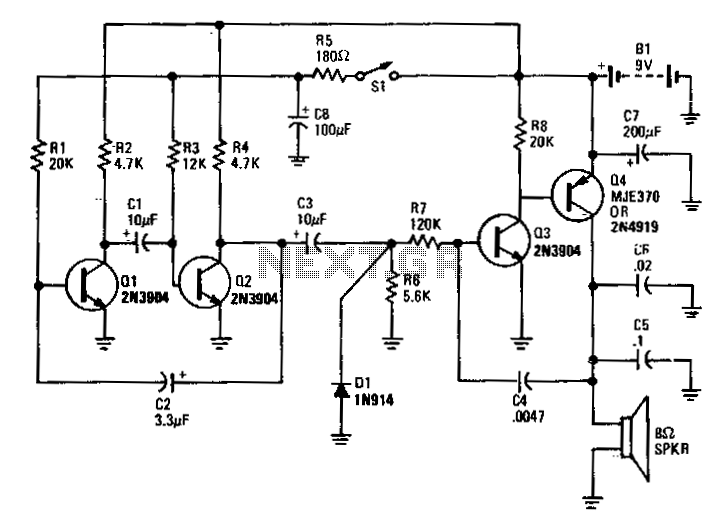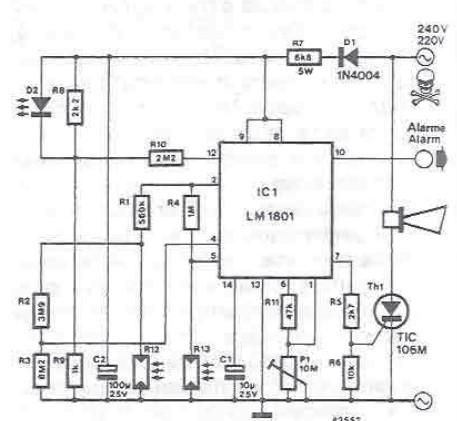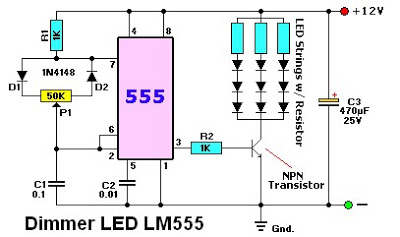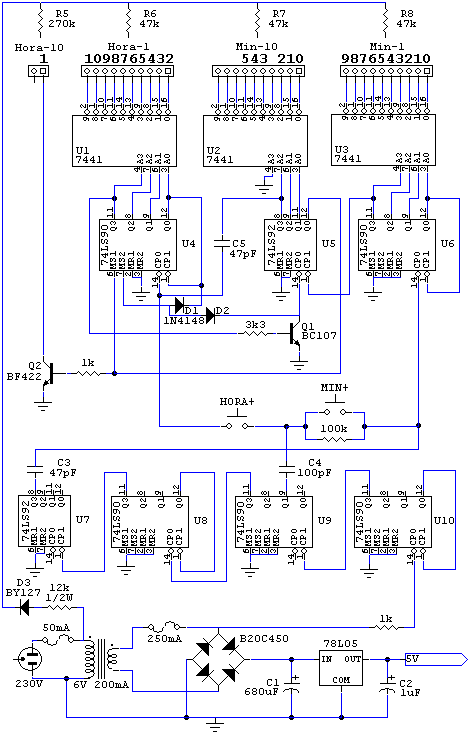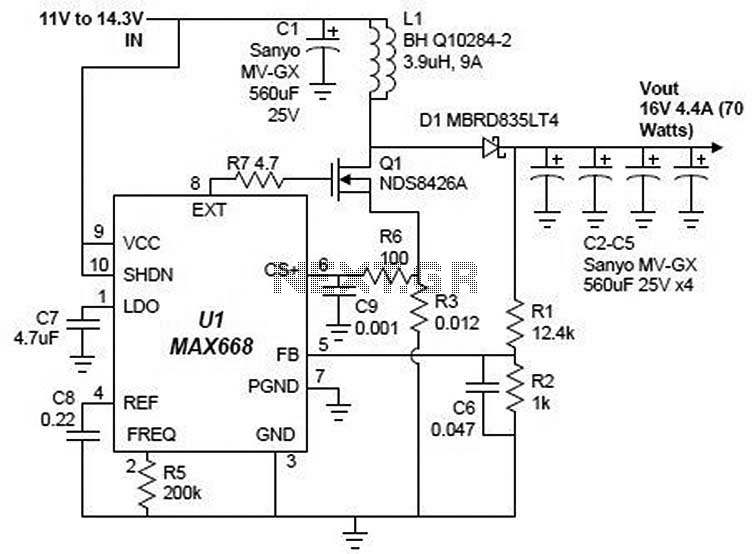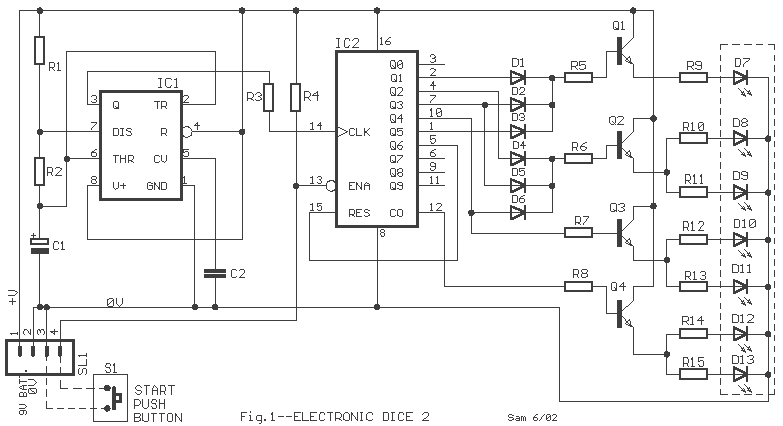
electronic dice
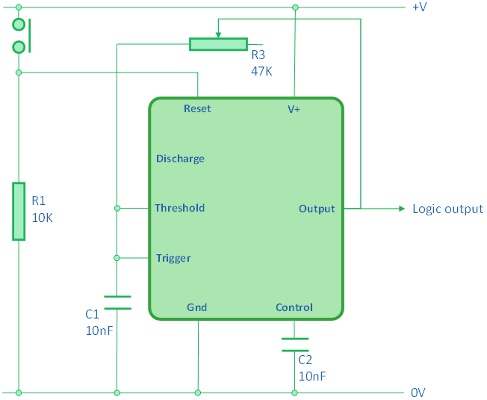
The 555 astable board utilizes a 555 timer configured in astable mode, producing a square wave or alternating high and low signals. The frequency of the signal is determined by capacitor C1 and variable resistor R3. This design is intended to generate a tone, enabling rapid switching on and off, which is necessary for the operation of a 7-segment display. The 555 timer's function is to create a clock signal activated by pressing a switch, which sequentially displays numbers on the 7-segment display. The circuit diagram for the 555 astable circuit is included below. The selected counter is a binary coded decimal (BCD) four-bit up/down counter (4510B), capable of counting from zero to nine or from nine to zero, with outputs represented in binary. The diagram illustrates the counter's operation when clocked, with a solid line indicating counting up and a dotted line indicating counting down. Each box displays the binary representation of the data present on the counter outputs Q3 to Q0. The chip features a Terminal Count (TC) output, enabling one counter to trigger another upon wrapping around. This pin can also reset the counter, being active low when counting up to nine or down to zero. Additionally, the chip has a Parallel Load (PL) function, allowing the loading of data from inputs P3 to P0 into the counter when the PL pin is high. This feature enables reloading the counter with any value, such as loading the value six and counting down. Upon reaching zero, the TC pin transitions from high to low, which can be utilized to reload the counter to six. However, since the PL pin is active high and the TC pin is active low, a signal inversion is required, necessitating the use of an NPN transistor and a pull-up resistor.
The 555 timer in the astable configuration operates by continuously charging and discharging capacitor C1, resulting in a square wave output. The frequency of oscillation is primarily influenced by the values of C1 and R3, which can be adjusted to achieve the desired tone frequency. This output is fed into the clock input of the 4510B counter, allowing it to increment or decrement its count based on the clock signal's state.
The 4510B counter is designed to handle binary-coded decimal (BCD) outputs, making it suitable for applications such as digital displays. The counter's ability to count both up and down provides versatility in various applications, including games or timers where countdown functionality is essential. The Terminal Count output serves as a crucial feature, allowing for cascading multiple counters in a system, enhancing the overall counting capability.
In applications requiring specific reloading of the counter, the Parallel Load function becomes vital. By setting the PL pin high, the counter can be loaded with a predetermined value, enabling quick resets or adjustments in counting. The interaction between the PL and TC pins, necessitating the use of an NPN transistor for signal inversion, exemplifies the need for careful circuit design to ensure compatibility between different logic levels.
Overall, the combination of the 555 timer and the 4510B counter in this circuit provides a robust solution for generating tones and managing numerical displays, with flexibility in counting direction and reloading capabilities.The 555 astable board uses a 555 timer in its astable configuration. This means that it outputs a square wave or a series of high and low signals. The speed that the signal goes high and low is set by the capacitor C1 and variable resistor R3. The board is designed to make a tone so will be switching quickly on and off which is just what`s require d for the 7 segment dice. The purpose of the 555 timer is to generate a clock signal whenever the switch is pressed. When this happens the 7 segment will be clocked through the various numbers. The circuit diagram of the 555 astable circuit is shown below: The counter selected is a binary coded decimal four bit up down counter (4510B). This means that it can either count up from zero to nine or down from 9 to 0 and that the output of this is indicated in binary.
The diagram above shows how the counter operates when clocked, the solid line indicating a clock when set to up and the dotted line shows the step when clocked in the down mode. The second number in each of the boxes is the binary representation of the data that will be present on the counter outputs Q3 to Q0.
The chip has a Terminal Count (TC) output, this is normally present to allow one counter to trigger another counter when the count wraps around. This pin can however be used to reset the counter itself. The pin is active low so will be low: if counting up - when it reaches nine or if counting down when it reaches zero.
The chip also has a Parallel Load (PL) function. When the PL pin is taken high the data on the inputs P3 to P0 are loaded into the counter. This functionality can be used to reload the counter with any value. So it is possible to load six and count down. When zero is reached the TC pin will change from high to low and this can be used to reload the counter to six. Unfortunately the PL pin is active high and the TC pin is active low, so they can`t be connected directly.
Instead an NPN transistor and pull up resistor need to be used to invert the signal. 🔗 External reference
The 555 timer in the astable configuration operates by continuously charging and discharging capacitor C1, resulting in a square wave output. The frequency of oscillation is primarily influenced by the values of C1 and R3, which can be adjusted to achieve the desired tone frequency. This output is fed into the clock input of the 4510B counter, allowing it to increment or decrement its count based on the clock signal's state.
The 4510B counter is designed to handle binary-coded decimal (BCD) outputs, making it suitable for applications such as digital displays. The counter's ability to count both up and down provides versatility in various applications, including games or timers where countdown functionality is essential. The Terminal Count output serves as a crucial feature, allowing for cascading multiple counters in a system, enhancing the overall counting capability.
In applications requiring specific reloading of the counter, the Parallel Load function becomes vital. By setting the PL pin high, the counter can be loaded with a predetermined value, enabling quick resets or adjustments in counting. The interaction between the PL and TC pins, necessitating the use of an NPN transistor for signal inversion, exemplifies the need for careful circuit design to ensure compatibility between different logic levels.
Overall, the combination of the 555 timer and the 4510B counter in this circuit provides a robust solution for generating tones and managing numerical displays, with flexibility in counting direction and reloading capabilities.The 555 astable board uses a 555 timer in its astable configuration. This means that it outputs a square wave or a series of high and low signals. The speed that the signal goes high and low is set by the capacitor C1 and variable resistor R3. The board is designed to make a tone so will be switching quickly on and off which is just what`s require d for the 7 segment dice. The purpose of the 555 timer is to generate a clock signal whenever the switch is pressed. When this happens the 7 segment will be clocked through the various numbers. The circuit diagram of the 555 astable circuit is shown below: The counter selected is a binary coded decimal four bit up down counter (4510B). This means that it can either count up from zero to nine or down from 9 to 0 and that the output of this is indicated in binary.
The diagram above shows how the counter operates when clocked, the solid line indicating a clock when set to up and the dotted line shows the step when clocked in the down mode. The second number in each of the boxes is the binary representation of the data that will be present on the counter outputs Q3 to Q0.
The chip has a Terminal Count (TC) output, this is normally present to allow one counter to trigger another counter when the count wraps around. This pin can however be used to reset the counter itself. The pin is active low so will be low: if counting up - when it reaches nine or if counting down when it reaches zero.
The chip also has a Parallel Load (PL) function. When the PL pin is taken high the data on the inputs P3 to P0 are loaded into the counter. This functionality can be used to reload the counter with any value. So it is possible to load six and count down. When zero is reached the TC pin will change from high to low and this can be used to reload the counter to six. Unfortunately the PL pin is active high and the TC pin is active low, so they can`t be connected directly.
Instead an NPN transistor and pull up resistor need to be used to invert the signal. 🔗 External reference
